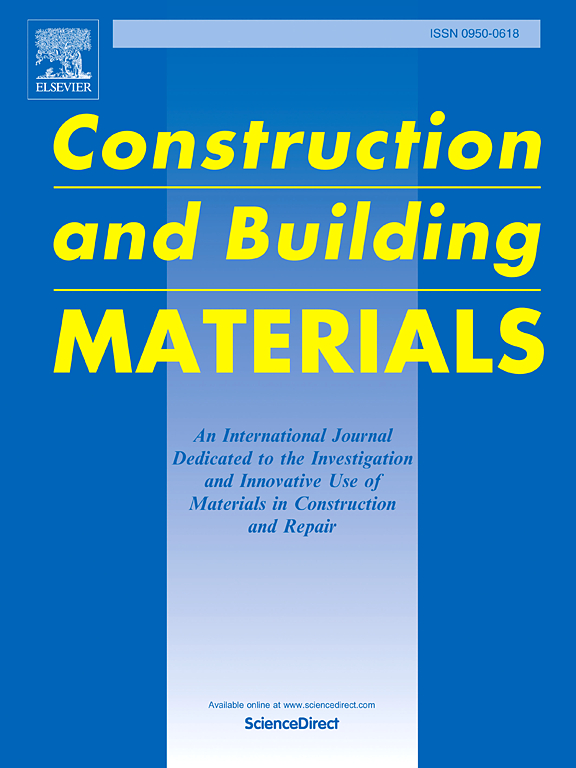Performance evaluation of pre-stressed high-strength concrete pipe piles produced with steel slag powder and ground quartz sand as composite supplementary cementitious materials
IF 7.4
1区 工程技术
Q1 CONSTRUCTION & BUILDING TECHNOLOGY
引用次数: 0
Abstract
Utilizing industrial solid waste as supplementary cementitious materials (SCMs) in the production of pre-stressed high-strength concrete (PHC) pipe piles can reduce the consumption of cement, thereby promoting the sustainable development of the pipe pile industry. This study focused on optimizing the use of composite SCMs including ground quartz sand (GQS) and steel slag powder (SSP) to enhance the mechanical properties and durability of PHC pipe pile concrete. The effects of GQS and SSP on the reaction products, microstructure, pore structure, mechanical properties and durability of PHC pipe pile concrete were investigated. Experimental results showed that due to the filling effect and pozzolanic effect of GQS and SSP, composite SCMs not only improves the microstructure of the interfacial transition zone between paste and aggregates in PHC pipe pile concrete, but also reduces the porosity of concrete and improves its pore structure, thereby enhancing the compressive strength and durability of concrete. When the GQS content is 20 % and the SSP content is 10 %, compared to the control group with 100 % cement, the concrete’s porosity decreased by 19.3 %, the chloride ion diffusion coefficient decreased by 47.1 %, and the compressive strength increased by 3.4 %. The findings of this study provide a scientific basis for the resource utilization of steel slag and offer theoretical support for the low-carbon and sustainable development of PHC pipe pile industry.
钢渣粉与石英砂复合补充胶凝材料制备预应力高强混凝土管桩的性能评价
利用工业固体废弃物作为补充胶凝材料(SCMs)生产预应力高强混凝土(PHC)管桩可以减少水泥的消耗,从而促进管桩行业的可持续发展。研究了石英砂(GQS)和钢渣粉(SSP)复合材料的优化使用,以提高PHC管桩混凝土的力学性能和耐久性。研究了GQS和SSP对PHC管桩混凝土的反应产物、微观结构、孔隙结构、力学性能和耐久性的影响。试验结果表明,由于GQS和SSP的填充效应和火山灰效应,复合SCMs不仅改善了PHC管桩混凝土中膏体与骨料界面过渡区的微观结构,而且降低了混凝土的孔隙率,改善了混凝土的孔隙结构,从而提高了混凝土的抗压强度和耐久性。GQS掺量为20 %,SSP掺量为10 %时,与掺量为100 %水泥的对照组相比,混凝土孔隙率降低19.3 %,氯离子扩散系数降低47.1 %,抗压强度提高3.4 %。研究结果为钢渣资源化利用提供了科学依据,为PHC管桩行业的低碳可持续发展提供了理论支持。
本文章由计算机程序翻译,如有差异,请以英文原文为准。
求助全文
约1分钟内获得全文
求助全文
来源期刊

Construction and Building Materials
工程技术-材料科学:综合
CiteScore
13.80
自引率
21.60%
发文量
3632
审稿时长
82 days
期刊介绍:
Construction and Building Materials offers an international platform for sharing innovative and original research and development in the realm of construction and building materials, along with their practical applications in new projects and repair practices. The journal publishes a diverse array of pioneering research and application papers, detailing laboratory investigations and, to a limited extent, numerical analyses or reports on full-scale projects. Multi-part papers are discouraged.
Additionally, Construction and Building Materials features comprehensive case studies and insightful review articles that contribute to new insights in the field. Our focus is on papers related to construction materials, excluding those on structural engineering, geotechnics, and unbound highway layers. Covered materials and technologies encompass cement, concrete reinforcement, bricks and mortars, additives, corrosion technology, ceramics, timber, steel, polymers, glass fibers, recycled materials, bamboo, rammed earth, non-conventional building materials, bituminous materials, and applications in railway materials.
 求助内容:
求助内容: 应助结果提醒方式:
应助结果提醒方式:


